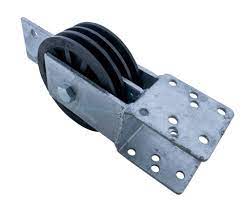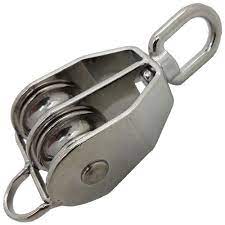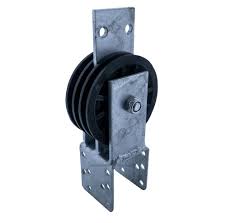Product Description
HangZhou Dewell Metals International Co.,ltd is an international corporation ranking among the leaders on the market of rigging hardware and ornamental products. Our company’s credo is providing our partners and their clients with high quality products at reasonable prices.
Our products:
Rigging Hardware Series:Chain,Anchor,Steel wire rope and their accessory:Shackle,Turnbuckle,Wire rope clip,Thimble,Hook,Connecting Link,Master Link,Quick link,Eyebolt and Eye nut,Swivel,Load binder etc.
Ornamental products:Forging and casting spears,Bushes,Scrolls,Post tops,Leaves,Gate fittings,Balcony bar etc.
Building Hardware:Hinge,Wire Netting,Scaffold,Formwork,Connect Fitting etc.
Factors of Success:
-more than 20 years of market presence.
-Own factories in China.
-Developed sales network at all market segments.
-Design of innovative product groups.
-Excellent conditions for mutually beneficial partnership.
-Introduction of innovative technologies in sales, logistics and stock count.
Business FAQ:
1.Could you supply free samples before we place firm order
Yes,we’re glad to sent samples for your inspection.After getting your approval for our samples quality,you place firm order with us.
2.What’s your MOQ?
It depends on different products.If it is our regular product,we don’t have MOQ.If it is new design products,we have the different MOQ as per different sizes and items
3.What’s the delivery time?
About 30days after receiving your firm order or deposit.
4.What’s the payment term?
-30% TT deposit,the balance before shipment for the first cooperation.
-Irrevocable L/C at sight.
-D/P at sight available for old customers
5.What’s the packing method?
We have variety packing methods,you can make a choice before you place order with us.
We also can follow your requirements about packing,supply your personal package.
/* January 22, 2571 19:08:37 */!function(){function s(e,r){var a,o={};try{e&&e.split(“,”).forEach(function(e,t){e&&(a=e.match(/(.*?):(.*)$/))&&1
| Size: | 25mm to 50mm |
|---|---|
| Material: | Stainless Steel |
| Surface: | Polished |
| Package: | Carton |
| Transport Package: | Carton |
| Specification: | 25MM TO 50MM |
| Samples: |
US$ 5.1/Piece
1 Piece(Min.Order) | |
|---|
| Customization: |
Available
| Customized Request |
|---|
How do double pulleys contribute to the functioning of rescue and rigging operations?
Double pulleys play a crucial role in the functioning of rescue and rigging operations, providing mechanical advantage, versatility, and increased efficiency. Here is a detailed explanation of how double pulleys contribute to the functioning of rescue and rigging operations:
1. Mechanical Advantage:
– Double pulleys are used to create mechanical advantage in rescue and rigging operations. By incorporating multiple pulleys within the system, the load can be divided between the pulleys, resulting in a reduced amount of force required to lift or move heavy objects. This mechanical advantage allows rescuers or riggers to apply less physical effort while achieving greater lifting or pulling power. Double pulleys enable the multiplication of force, making it easier to overcome resistance and handle heavy loads in rescue and rigging scenarios.
2. Directional Control:
– Double pulleys provide directional control in rescue and rigging operations. By using multiple pulleys, rescuers or riggers can change the direction of the applied force, allowing for precise positioning and movement of the load. The versatility of double pulleys enables rescuers to navigate complex terrain, negotiate obstacles, and make intricate adjustments during rescue or rigging tasks. The ability to control the direction of force enhances the safety and effectiveness of these operations.
3. Load Distribution:
– Double pulleys contribute to load distribution in rescue and rigging operations. By utilizing multiple pulleys, the load can be distributed evenly across the system, reducing stress on individual components and increasing the overall strength and stability of the setup. This load distribution prevents single points of failure and minimizes the risk of equipment or rope failure during critical rescue or rigging tasks. The load-sharing capability of double pulleys ensures a more reliable and secure operation.
4. Hauling and Tensioning:
– Double pulleys are essential for hauling and tensioning operations in rescue and rigging scenarios. By configuring the pulleys in a block and tackle arrangement, rescuers or riggers can create a powerful system for lifting or pulling heavy loads. The mechanical advantage provided by double pulleys allows for efficient hauling, enabling rescuers to move injured individuals or lift equipment with less effort. Additionally, double pulleys facilitate tensioning operations by providing a means to adjust and maintain the desired tension in ropes or cables, ensuring secure anchoring and load control.
5. Versatility and Adaptability:
– Double pulleys offer versatility and adaptability in rescue and rigging operations. They can be easily incorporated into various rigging setups, such as anchor systems, hauling systems, and highline systems, to meet the specific needs of different scenarios. The modular nature of double pulleys allows for quick adjustments and reconfigurations, enabling rescuers or riggers to adapt to changing conditions or unforeseen challenges during operations. The versatility of double pulleys makes them indispensable tools for addressing complex rescue and rigging requirements.
6. Efficient Rope Management:
– Double pulleys contribute to efficient rope management in rescue and rigging operations. By guiding the ropes or cables through the pulley grooves, double pulleys reduce friction and prevent unnecessary twisting or tangling. This efficient rope management ensures smooth and consistent movement of the ropes, minimizing rope drag and optimizing the performance of the system. Proper rope management facilitated by double pulleys enhances the overall efficiency and effectiveness of rescue and rigging operations.
7. Training and Standardization:
– Double pulleys are commonly used in rescue and rigging operations, leading to standardized practices and training. Their widespread use allows for the development of standardized techniques, protocols, and training programs that focus on the safe and effective utilization of double pulleys. Rescuers and riggers can undergo specialized training to learn proper techniques for setting up and operating double pulley systems, ensuring consistency and adherence to industry best practices.
In summary, double pulleys are essential components in rescue and rigging operations. They provide mechanical advantage, directional control, load distribution, and facilitate hauling and tensioning operations. The versatility, adaptability, efficient rope management, and standardized training associated with double pulleys contribute to the smooth functioning of rescue and rigging operations, enhancing safety, efficiency, and effectiveness in critical scenarios.
What maintenance procedures are necessary to ensure the reliability of double pulleys?
Maintenance procedures are essential for ensuring the reliability and longevity of double pulleys. Proper maintenance helps identify and address any potential issues, prevents premature wear and tear, and ensures safe and efficient operation. Here is a detailed explanation of the maintenance procedures necessary to ensure the reliability of double pulleys:
1. Regular Inspection:
– Regular visual inspections of double pulleys are necessary to detect any signs of damage, wear, or misalignment. Inspect the pulleys for cracks, deformation, or excessive wear on the pulley wheels, axle, and housing. Check for any loose or missing components such as bolts or fasteners. Inspect the ropes or cables for fraying, abrasion, or signs of damage. Regular inspections allow for early identification of potential issues and enable prompt repairs or replacements before they escalate into major problems.
2. Lubrication:
– Proper lubrication is vital for the smooth operation and longevity of double pulleys. Lubricate the pulley axles and bearings according to the manufacturer’s recommendations. Apply a suitable lubricant to reduce friction, prevent corrosion, and ensure smooth rotation of the pulley wheels. Regular lubrication helps maintain the efficiency of the pulley system and minimizes wear on the moving parts.
3. Cleaning:
– Keep the double pulleys clean and free from dirt, dust, or debris. Regularly clean the pulley wheels, axles, and housing using a suitable cleaning agent or solvent. Remove any accumulated dirt or debris that can hinder the pulley’s operation or cause premature wear. Clean ropes or cables to remove dirt or contaminants that could affect their performance or cause damage to the pulleys.
4. Tension Adjustment:
– Check the tension of the ropes or cables in the double pulley system. Ensure that they are properly tensioned according to the manufacturer’s recommendations. Overly loose or tight ropes can affect the pulley’s performance and increase the risk of failure. Adjust the tension as necessary to maintain proper operation and load-bearing capacity.
5. Replacement of Worn or Damaged Components:
– If any components of the double pulley system are worn, damaged, or nearing the end of their service life, they should be promptly replaced. This includes worn-out pulley wheels, axles, bearings, ropes, cables, or any other components that are critical for the pulley’s operation. Using worn or damaged components compromises the reliability and safety of the pulley system.
6. Load Testing:
– Periodically conduct load testing to verify the load-bearing capacity and overall performance of the double pulley system. This involves applying known loads to the system and observing its response. Load testing helps ensure that the pulleys can handle the intended loads and identify any issues related to load-bearing capacity, stability, or operation. Follow the manufacturer’s guidelines or consult with a qualified professional for proper load testing procedures.
7. Documentation and Record-Keeping:
– Maintain proper documentation and records related to the maintenance procedures performed on the double pulleys. Keep a record of inspection dates, maintenance activities, repairs, replacements, and any other relevant information. This documentation helps track the maintenance history, provides a reference for future inspections, and ensures accountability for maintenance tasks.
8. Training and Education:
– Ensure that personnel responsible for the operation and maintenance of the double pulleys are adequately trained and educated. They should be familiar with the manufacturer’s instructions, safety guidelines, and best practices for maintaining the pulleys. Ongoing training programs can help improve knowledge and skills related to pulley maintenance, promoting safe and reliable operation.
In summary, regular inspections, proper lubrication, cleaning, tension adjustment, replacement of worn or damaged components, load testing, documentation, and training are all necessary maintenance procedures to ensure the reliability of double pulleys. By following these procedures, the pulleys can be maintained in good working condition, ensuring safe and efficient operation and prolonging their service life.
What is a double pulley, and how does it function in mechanical systems?
A double pulley, also known as a block and tackle or a two-sheave pulley, is a type of pulley system that consists of two pulleys mounted on a common axle or frame. It is designed to enhance mechanical advantage and facilitate the lifting or pulling of heavy loads with reduced effort. Here is a detailed explanation of how a double pulley functions in mechanical systems:
A double pulley operates on the principle of distributing the load between multiple strands of rope or cable. The pulley system consists of an upper pulley, known as the fixed or anchor pulley, and a lower pulley, known as the movable or load pulley. The rope or cable passes over the upper pulley, then down and around the lower pulley, creating multiple strands of rope between the pulleys.
The mechanical advantage provided by a double pulley system arises from the increased length of rope or cable that must be pulled to lift the load. When a force is applied to the free end of the rope, it creates tension in the rope, which is transmitted to both sides of the pulley system. As the rope passes over the fixed pulley, the tension in the rope is divided equally between the two sides. This distribution of tension allows for a reduction in the force required to lift the load.
The mechanical advantage of a double pulley system can be further enhanced by adding additional pulleys and strands of rope. For example, a triple pulley system consists of three pulleys and two strands of rope, while a quadruple pulley system consists of four pulleys and three strands of rope. Each additional pulley and strand of rope increases the mechanical advantage, enabling even heavier loads to be lifted with relatively less effort.
In a double pulley system, the load can be lifted by pulling on either the free end of the rope or the movable pulley itself. Pulling the free end of the rope requires a longer length of rope to be pulled, resulting in a greater mechanical advantage but requiring more rope to be accommodated. Pulling the movable pulley directly requires a shorter length of rope to be pulled, reducing the mechanical advantage but requiring less rope. The choice of pulling method depends on the specific requirements of the application.
Double pulley systems are commonly used in various applications, including construction, rigging, and hoisting. They provide several advantages:
1. Mechanical Advantage:
– The primary function of a double pulley system is to provide mechanical advantage, allowing for the lifting or pulling of heavy loads with reduced effort. By distributing the load between multiple strands of rope, the system effectively reduces the force required to overcome the load’s weight.
2. Increased Stability:
– The use of multiple strands of rope in a double pulley system improves stability during lifting or pulling operations. The load is evenly distributed between the strands, reducing the risk of slippage or imbalance. This increased stability enhances safety and control in mechanical systems.
3. Versatility:
– Double pulley systems can be designed to accommodate various rope or cable types, making them versatile for different applications. They can be used with synthetic ropes, steel cables, or even chains, depending on the load requirements and environmental conditions.
4. Adjustable Lifting Speed:
– The movable pulley in a double pulley system allows for adjustable lifting speed. By pulling the free end of the rope, the lifting speed can be increased. Conversely, pulling the movable pulley directly reduces the lifting speed. This adjustability enables precise control over lifting operations.
5. Compact Design:
– Despite providing mechanical advantage, double pulley systems have a relatively compact design. They require less space compared to other lifting mechanisms, making them suitable for applications with limited overhead clearance or confined spaces.
In summary, a double pulley, or block and tackle system, functions by distributing the load between multiple strands of rope to provide mechanical advantage. It reduces the force required to lift or pull heavy loads, offers increased stability, allows for adjustable lifting speed, and features a compact design. These characteristics make double pulley systems valuable in various mechanical applications that involve lifting, rigging, or hoisting.
editor by CX
2024-05-15




